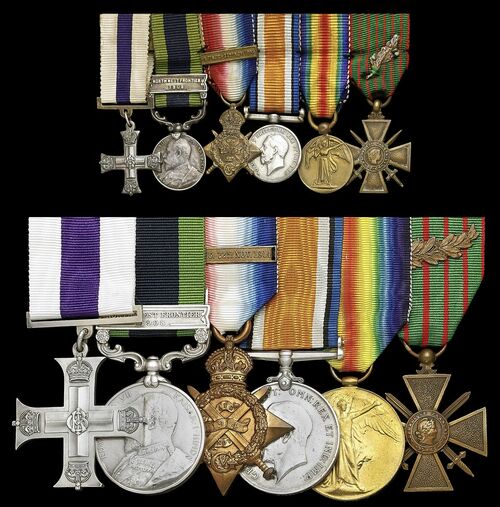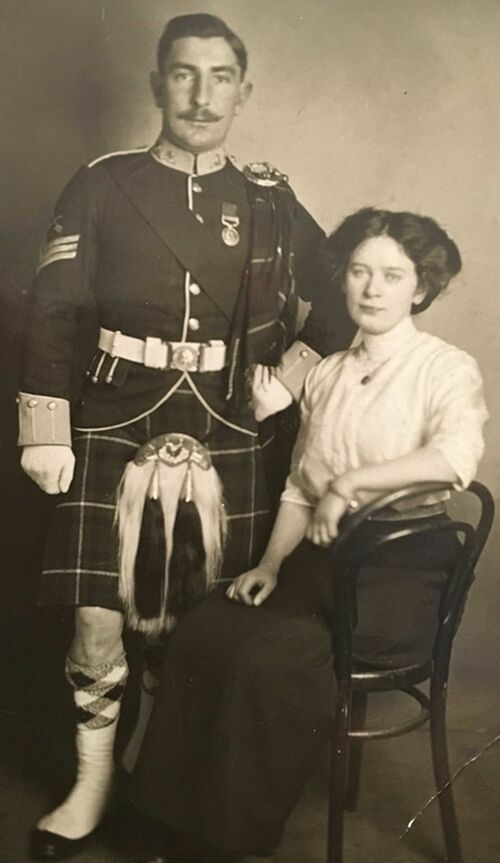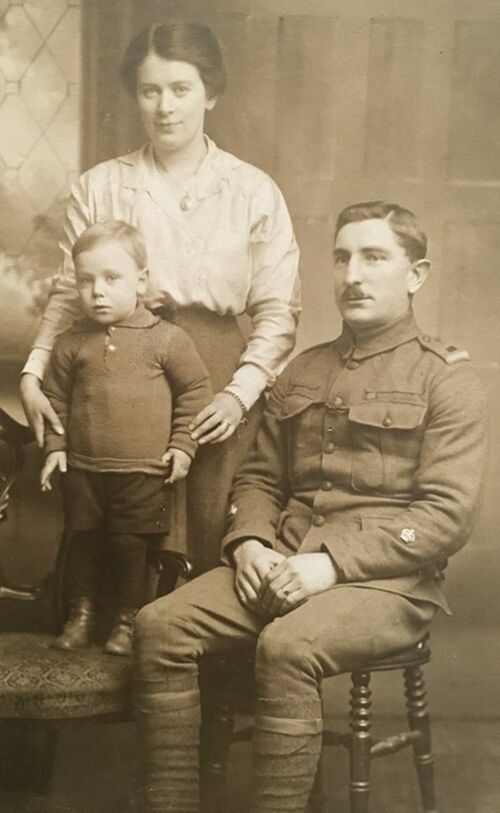Auction: 23003 - Orders, Decorations and Medals
Lot: 270
A Great War M.C. group of six awarded to 2nd Lieutenant A. Reid, Scottish Rifles, late Argyll and Sutherland Highlanders
Military Cross, G.V.R., engraved on reverse 'Lt. A. Reid 19.9.18 The Cameronians'; India General Service 1908-35, 1 clasp, North West Frontier 1908 (8794 Lance Corporal A. Reid. 1st Bn. Seaforth Highlanders.); 1914 Star, clasp (8794 Pte A. Reid. 1/Sea: Highrs.); British War and Victory Medals (2. Lieut. A. Reid.); France, Republic, Croix de Guerre, reverse dated '1914-1916', with Palme upon riband, some contact marks, otherwise very fine (6)
M.C. London Gazette 1 February 1919:
'For gallantry and devotion to duty on the 19th September, 1918. Although suffering from gas poisoning at the commencement of operations, he led his company in the assault with great dash. By personal example and capable organisation of the mixed units of the brigade, who came later under his command, he was mainly responsible for the firm stand maintained on The Tongue against enemy counter-attacks, Under an intense bombardment and machine-gun fire he set a fine example to all with him.'
French Croix de Guerre London Gazette 21 July 1919.
Alexander Reid was born at 5 Milnescourt, Lawnmarket, Edinburgh on 3 May 1887, the son of Alexander and Janet Reid. Enlisting before the Great War he appears on the 1911 census with the 1st Battalion, Seaforth Highlanders in India, having already been promoted Corporal. Upon the outbreak of the Great War he entered the war in France on 12 October 1914.
Tranferred to the Scottish Rifles as Colour Sergeant Major on 27 June 1917 he was Commissioned 2nd Lieutenant on 17 May 1918 with the 11th Battalion. It was with this unit that Reid was to join the action at Salonika and commit his act of gallantry.
The Second Battle of Doiran
The 11th Battalion was still in the Horshoe Hill area and in No. 3 sector in the trenches at the time when the Franco-Serbian assault was launched on 15 September 1918. Two companies were holding the front line and two were lying in battalion reserve behind. The defences were subjected to a heavy artillery and trench-mortar bombardment by the enemy, and there were frequent bursts of machine-gun fire against the British wire throughout the day. Because of the change-over of infantry Brigades for the projected assault on the 18 September, Headquarters of the 11th Battalion and its two companies lying in reserve to No.3 sector were relieved during the night of the 15-16 September by troops of the 65th Brigade and were sent back to Kidney Camp to prepare there for battle. The enemy put 200 shells into that camp on the second morning but without causing any casualties. The battalion was moved to Kirech on the night of the 17-18 September, to be retained in reserve with the remainder of the 77th Brigade, a position behind the Seres Division and the 22nd Division.
XII Corps' attack was launched at 05:08 on 18 September. The Greek Seres Division fought with great ferocity, but after being counter-attacked succeeded only in consolidating the line Doiran-Teton-Hill 340. The 22nd Division had to abandon its captured objectives and at the end of the day only O6, next to Hill 340, was retained in its possession. A renewed attack was ordered for 05:15 the next day. This time there were to be limited objectives, the Seres Division on the right was to seize the final objectives of the day before. In the centre the 77th Infantry Brigade was to capture in turn the Sugar Loaf, the Knot and the Tassel, the Rockies and the Plume. The Zouaves were to capture P3 and a battalion of the 65th Brigade P4.
Battalions of the 77th Brigade were to attack with the 11th Battalion on the right, the 8th Royal Scots Fusiliers in the centre and the 12th Argyll and Sutherland Highlanders on the left. Two Battalions of the 65th Brigade were to be in support of the 77th Brigade. The 11th Battalion's objectives were, first, the Fang, second, the Knot and trenches below the Tassel and, thirdly, the Tassel.
The 11th Battalion, commanded by Major F.W.Scougal, left Sennelje Camp where it had been in reserve for the attack the day before at 03:00 on 19 September. Moving by the Vladaja Ravine the enemy sent over a number of gas-shells which were not at first recognized by the troops owing to the smoke and fumes of lyddite, and so box respirators were not used quickly enough. Many men were affected, including Reid.
The battalion arrived at the assembly area at 05:12 and formed up in two waves, each wave consisting of two companies, Nos. 4 and 2 in the first wave led by Captain M. McGibbon and Nos. 3 and 1 in the second wave commanded by Captain D. R. Orr. The role of the first wave was to take the Fang with No.2 Company, followed by No.4 which was to mop up the Fang trenches. The second wave, passing over the Fang trenches, was to swing to the right to take the Knot with No.3 Company, and then Nos. 1, 2 and 4 Companies were to seize the Tassel.
The barrage fell on the first objective at 05:15 and the men moved forward. The Fang was captured without difficulty and at 05:23 the barrage lifted to the second objective. The second wave then crossed the Fang trenches and No. 3 Company swung to the right and advanced on the Knot. It was anticipated that the Greeks, on the right, would have been in occupation of the Hilt but they were not. Machine-gun fire was directed on to the men of No. 3 Company from the Hilt, the Blade at the Sceptre. It was of such intensity that no progress could be made. No. 3 Company therefore pushed on after the other three companies, advancing against the trench between the Tongue and the Tassel. After very sharp fighting the trench was taken and the battalion was reorganized for its final effort. Leaving one company in the trench to mop up, the three remaining companies pushed on to the Tassel, but meeting with such intense fire from three directions, could not get beyond the wire protecting that work. Accordingly, the survivors made their way back to the trench between the Tongue and the Tassel. It was not possible to remain in this trench for long, however, because the enemy concentrated artillery, trench-mortar and machine-gun fire upon it from the Hilt on the right, which the Greeks had been unable to hold after its capture.
Finding it untenable the survivors moved to the left and joined up with the Royal Scots Fusiliers and the Argyll and Sutherland Highlanders now on the Tongue. This position was held until about 09:45, under Reid's command, all the more senior officers in the assaulting companies having become casualties.
Since the Zouaves on the left had not advanced beyond Doljeli village the force now holding the Tongue had both flanks in the air. The survivors of the three battalions, under command of Lieutenant-Colonel Falconer Stewart of the Argyll and Sutherland Highlanders, were the target for a great proportion of the enemy' artillery as well as trench mortars and innumerable machine-guns in adjoining works and trenches. Three successive counter-attacks were beaten off. The first two were dispersed by rifle and machine-gun fire. In the third, the men of the Scottish Rifles, having no ammunition, hurled captured stick grenades and large stones, then left the trench and charged the enemy with the bayonet and rove him off.
Meanwhile, as there was no British artillery fire on P Ridge where it was urgently required and which the Brigade Commander had requested, it was clear to Lieutenant-Colonel Stewart that within a very short time every man of the three battalions on the hill would be killed or captured by the Bulgarians. He ordered a withdrawal at 10.30 a.m., taking back as many wounded as possible. Reid thereupon led the 11th Battalion down the Vladaja Ravine, back to the defences from which the men debouched at 05:15. The 9th Royal Scots Fusiliers and 12th Argyll and Sutherland Highlanders followed.
The attack had failed everywhere. Not a yard of ground beyond that taken on the 18 September had been won, though the gains of that day had been retained. The 11th Batalion suffered a total of 2 Officers Killed, 1 Died of Wounds and 12 wounded including Reid, with a further two Officers missing. The number of Other Ranks killed and missing totalled 173 with a further 40 missing.
Reid retired from the Army on 21 June 1919 with the rank of 2nd Lieutenent, he returned to his home town of Edinburgh; sold together with a copy of his original Military Cross citation, this dated 3 November 1918 and signed by the Major General Commanding 26th Division as well as copied census data.
Subject to 20% VAT on Buyer’s Premium. For more information please view Terms and Conditions for Buyers.
Sold for
£1,200
Starting price
£800









